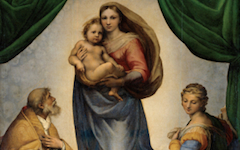Raphael’s Galatea (1512)
We have seen elsewhere how artists use the arrows of St. Sebastian, the saint's identifying attribute, as symbols for their own paintbrushes. Not only does the long, thin shape of an arrow resemble a brush but in pointing inwards, towards the saint, they suggest that “every painter paints himself.”
Raphael used spiritelli or putti for the same purpose in the Galatea even though they were not part of the story on which Galatea is based. Three of them shoot their arrow/brushes from the sky towards their motif, the story below.
Click next thumbnail to continue
As if to confirm such an interpretation, a fourth spiritello in the top left-hand corner holds extra arrow/brushes for his colleagues. Yet he does not store them in a quiver on his back as an archer might but bunched together in his hands like an artist might hold his brushes.
Click next thumbnail to continue
Years later Michelangelo portrayed St. Sebastian holding his arrow/brushes in a similar way and, as explained elsewhere, posed him as though he was his own executioner, thus strengthening the implication that “every painter paints himself.”
See conclusion below
For examples of how other artists have portrayed arrow/brushes in paintings of St. Sebastian, see Mantegna, Durer, Michelangelo , Hans Baldung Grien, Carlo Crivelli, Perugino, Antonio Campi and, more recently, by Egon Schiele.
More Works by Raphael
Sometimes the most difficult features to see in art are the most obvious

Raphael’s Sistine Madonna, Part 1 (1512)
Notes:
Original Publication Date on EPPH: 20 Apr 2010. | Updated: 0. © Simon Abrahams. Articles on this site are the copyright of Simon Abrahams. To use copyrighted material in print or other media for purposes beyond 'fair use', you must obtain permission from the copyright owner. Websites may link to this page without permission (please do) but may not reproduce the material on their own site without crediting Simon Abrahams and EPPH.





